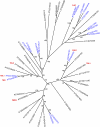TRICHOME BIREFRINGENCE and its homolog AT5G01360 encode plant-specific DUF231 proteins required for cellulose biosynthesis in Arabidopsis
- PMID: 20388664
- PMCID: PMC2879772
- DOI: 10.1104/pp.110.153320
TRICHOME BIREFRINGENCE and its homolog AT5G01360 encode plant-specific DUF231 proteins required for cellulose biosynthesis in Arabidopsis
Abstract
The Arabidopsis (Arabidopsis thaliana) trichome birefringence (tbr) mutant has severely reduced crystalline cellulose in trichomes, but the molecular nature of TBR was unknown. We determined TBR to belong to the plant-specific DUF231 domain gene family comprising 46 members of unknown function in Arabidopsis. The genes harbor another plant-specific domain, called the TBL domain, which contains a conserved GDSL motif known from some esterases/lipases. TBR and TBR-like3 (TBL3) are transcriptionally coordinated with primary and secondary CELLULOSE SYNTHASE (CESA) genes, respectively. The tbr and tbl3 mutants hold lower levels of crystalline cellulose and have altered pectin composition in trichomes and stems, respectively, tissues generally thought to contain mainly secondary wall crystalline cellulose. In contrast, primary wall cellulose levels remain unchanged in both mutants as measured in etiolated tbr and tbl3 hypocotyls, while the amount of esterified pectins is reduced and pectin methylesterase activity is increased in this tissue. Furthermore, etiolated tbr hypocotyls have reduced length with swollen epidermal cells, a phenotype characteristic for primary cesa mutants or the wild type treated with cellulose synthesis inhibitors. Taken together, we show that two TBL genes contribute to the synthesis and deposition of secondary wall cellulose, presumably by influencing the esterification state of pectic polymers.
Figures








Similar articles
-
Involvement of TBL/DUF231 proteins into cell wall biology.Plant Signal Behav. 2010 Aug;5(8):1057-9. doi: 10.4161/psb.5.8.12414. Epub 2010 Aug 1. Plant Signal Behav. 2010. PMID: 20657172 Free PMC article.
-
Mutations in the Pectin Methyltransferase QUASIMODO2 Influence Cellulose Biosynthesis and Wall Integrity in Arabidopsis.Plant Cell. 2020 Nov;32(11):3576-3597. doi: 10.1105/tpc.20.00252. Epub 2020 Sep 3. Plant Cell. 2020. PMID: 32883711 Free PMC article.
-
TBL3 and TBL31, Two Arabidopsis DUF231 Domain Proteins, are Required for 3-O-Monoacetylation of Xylan.Plant Cell Physiol. 2016 Jan;57(1):35-45. doi: 10.1093/pcp/pcv172. Epub 2015 Nov 9. Plant Cell Physiol. 2016. PMID: 26556650
-
Cellulose biosynthesis in plants: from genes to rosettes.Plant Cell Physiol. 2002 Dec;43(12):1407-20. doi: 10.1093/pcp/pcf164. Plant Cell Physiol. 2002. PMID: 12514238 Review.
-
Arabidopsis - a powerful model system for plant cell wall research.Plant J. 2010 Mar;61(6):1107-21. doi: 10.1111/j.1365-313X.2010.04161.x. Plant J. 2010. PMID: 20409281 Review.
Cited by
-
Construction of a supF-based system for detection of mutations in the chromosomal DNA of Arabidopsis.Mol Genet Genomics. 2013 Dec;288(12):707-15. doi: 10.1007/s00438-013-0783-3. Epub 2013 Oct 24. Mol Genet Genomics. 2013. PMID: 24154629
-
Physiological and transcriptomic analyses reveal the mechanisms underlying the salt tolerance of Zoysia japonica Steud.BMC Plant Biol. 2020 Mar 14;20(1):114. doi: 10.1186/s12870-020-02330-6. BMC Plant Biol. 2020. PMID: 32169028 Free PMC article.
-
An advanced method for the release, enrichment and purification of high-quality Arabidopsis thaliana rosette leaf trichomes enables profound insights into the trichome proteome.Plant Methods. 2022 Jan 28;18(1):12. doi: 10.1186/s13007-021-00836-0. Plant Methods. 2022. PMID: 35086542 Free PMC article.
-
O-acetylation of Arabidopsis hemicellulose xyloglucan requires AXY4 or AXY4L, proteins with a TBL and DUF231 domain.Plant Cell. 2011 Nov;23(11):4041-53. doi: 10.1105/tpc.111.091728. Epub 2011 Nov 15. Plant Cell. 2011. PMID: 22086088 Free PMC article.
-
Analysis and review of trichomes in plants.BMC Plant Biol. 2021 Feb 1;21(1):70. doi: 10.1186/s12870-021-02840-x. BMC Plant Biol. 2021. PMID: 33526015 Free PMC article. Review.
References
-
- Akoh CC, Lee GC, Liaw YC, Huang TH, Shaw JF. (2004) GDSL family of serine esterases/lipases. Prog Lipid Res 43: 534–552 - PubMed
-
- Altamura MM, Zaghi D, Salvi G, De Lorenzo G, Bellincampi D. (1998) Oligogalacturonides stimulate pericycle cell wall thickening and cell divisions leading to stoma formation in tobacco leaf explants. Planta 204: 429–436
-
- Arioli T, Peng L, Betzner AS, Burn J, Wittke W, Herth W, Camilleri C, Höfte H, Plazinski J, Birch R, et al. (1998) Molecular analysis of cellulose biosynthesis in Arabidopsis. Science 279: 717–720 - PubMed
Publication types
MeSH terms
Substances
Associated data
- Actions
LinkOut - more resources
Full Text Sources
Other Literature Sources
Molecular Biology Databases

